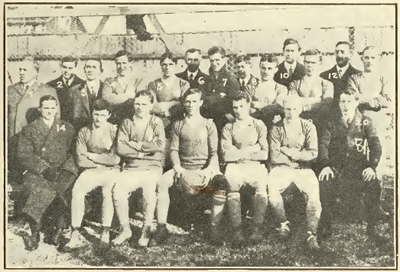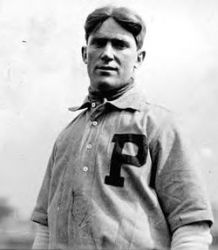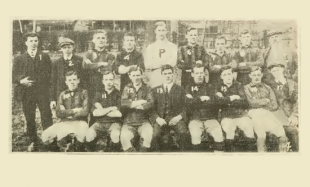Photo: Peabody FC
Our series looking back at Philly soccer happenings one hundred years ago continues.
Weeks of bad winter weather had thrown the 1913-1914 soccer season in Philadelphia into disarray. A terrible January had been replaced with an even worse February, with games across the region being canceled on the Feb. 14 and Feb. 21 matchdays. The week leading up to the Feb. 28 matchday began with snow and the temperature never rising above 30 degrees before highs in the forties on Thursday and Friday. As a result, frozen fields were turned into “a sea of mud,” a phrase seen all too frequently by local soccer fans that winter in the pages of the Philadelphia Inquirer. In all, nearly 17 inches of snow fell on the city that February.
The result, as the Inquirer reported on March 3, was that soccer in Philadelphia was “at a standstill as far as games being played.”
Despite the conditions, two Allied American Cup tournament games were played on Feb. 28, 1914, even if only one of them took place in the city. Both games were blowouts.
Playing at Harrowgate and Nicetown lanes, Fairhill Wanderers walked over Peabody to the tune of seven goals to one. While Peabody arrived a man short, the conditions were probably a more daunting challenge than playing with only ten men. As the Inquirer match report on March 1 described, “The field was a sea of slush and mud, and both teams labored through this for ninety minutes before they could leave.”
At East End Field in Bethlehem, Bethlehem FC had an easy 9-0 win over Allied League third division side Centenary FC. While the Inquirer match report on March 1 noted, “The Centenary’s chief weakness was the inability to score in front of net,” the description of the field conditions again stands out. The Inquirer reported, “The field was very sloppy, pools appearing in many places, making fast play treacherous and the control of the ball difficult.”
One other game also took place outside of the city. Preparing for the spring collegiate season, Haverford College defeated the Merion Cricket Club first team 5-4 on “a field heavy with snow.”
While the game may have been at a standstill in Philadelphia, movement was a foot for a new Tri-State League comprised of teams from Philadelphia, New York, and Newark, Patterson, and Jersey City in northern New Jersey. As first reported by the Inquirer on Feb. 15, 1914, the three reaming team’s of the Philadelphia’s professional Pennsylvania League — Hibernian, Tacony, and Victor — were among the probable entries in the proposed league. The once proud league had seen its fortunes decline after a drop in attendance following an increase in ticket prices from 15¢ to 25¢, the equivalent of a rise in price from about $3.50 to about $5.85. More importantly, the quality of play in the area’s booming amateur leagues, particularly in the Allied American League first division, had meant that good soccer could be seen for free. For teams that relied on matchday receipts, the prospect of offering the paying public a higher level and wider field of competition was a very attractive proposition, indeed. On March 2, the Inquirer reported that Tacony had joined Victor in announcing their support for the new league with only Hibernian yet to make a decision.
The Inquirer report on Feb. 15 raised an interesting issue for the teams that might be involved in the new league. Because Pennsylvania’s Blue Laws prohibited games on Sunday, Philadelphia leagues played on a Saturday schedule. Teams in New Jersey and New York had no such restrictions and so most area leagues played on a Sunday schedule. As the Inquirer reported, this meant that players from those states “would lose a day’s work every Saturday when they are due to play in this city, as Sunday ball predominates in the cities which will be involved along with this city.” The Inquirer described, “To offset that and help to make sure of covering expenses, a guarantee is being talked of for the visiting teams, while local elevens playing away on Sundays will also receive the same guarantee.”
The Inquirer was hopeful that the new league would come to fruition. “With a league of this kind in existence the brand of ball exhibited would rank on par with anything in the country, and as the distance between the various cities is not so extensive, traveling expenses would not be over large and would more than be counterbalanced by the increased returns to the box office.”
Meanwhile, the weather took another turn for the worse when another winter storm rolled through the region on March 1-2 that left another six inches of snow on the city and saw temperatures drop to as low as 16 degrees. The Inquirer reported on March 3, “When the promoters, managers and fellow sportsmen awoke yesterday they found all avenues, except snow shoveling, closed to them, Even the sleighers were put out of business by the high wind and mountainous drifts. The milkmen were the only ones to engage in the great winter pastime, being early on the scene with their runners.”
The storm was a big one, reaching as far south as North Carolina where the Phillies were beginning spring training, and where the temperature was 22 degrees with 43-mile-an-hour winds. The Inquirer reported on March 3, “Despite the penetrating wind and the snow-covered field, [Manager Charles “Red” Dooin] hustled the squad out to the ball park in the afternoon and with a soccer ball put them through a vigorous workout. For two hours the men kicked the inflated sphere to all corners of the lot, perspiring and reducing some of their winter’s surplus weight.”




Comments